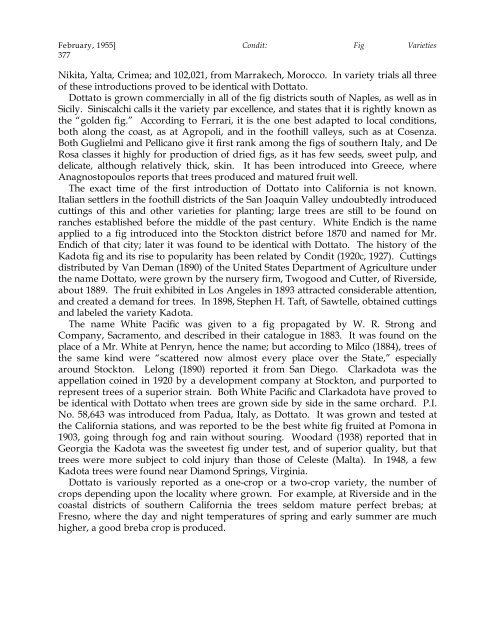Fig Varieties: A Monograph - uri=ucce.ucdavis
Fig Varieties: A Monograph - uri=ucce.ucdavis
Fig Varieties: A Monograph - uri=ucce.ucdavis
You also want an ePaper? Increase the reach of your titles
YUMPU automatically turns print PDFs into web optimized ePapers that Google loves.
February, 1955] Condit: <strong>Fig</strong> <strong>Varieties</strong><br />
377<br />
Nikita, Yalta, Crimea; and 102,021, from Marrakech, Morocco. In variety trials all three<br />
of these introductions proved to be identical with Dottato.<br />
Dottato is grown commercially in all of the fig districts south of Naples, as well as in<br />
Sicily. Siniscalchi calls it the variety par excellence, and states that it is rightly known as<br />
the “golden fig.” According to Ferrari, it is the one best adapted to local conditions,<br />
both along the coast, as at Agropoli, and in the foothill valleys, such as at Cosenza.<br />
Both Guglielmi and Pellicano give it first rank among the figs of southern Italy, and De<br />
Rosa classes it highly for production of dried figs, as it has few seeds, sweet pulp, and<br />
delicate, although relatively thick, skin. It has been introduced into Greece, where<br />
Anagnostopoulos reports that trees produced and matured fruit well.<br />
The exact time of the first introduction of Dottato into California is not known.<br />
Italian settlers in the foothill districts of the San Joaquin Valley undoubtedly introduced<br />
cuttings of this and other varieties for planting; large trees are still to be found on<br />
ranches established before the middle of the past century. White Endich is the name<br />
applied to a fig introduced into the Stockton district before 1870 and named for Mr.<br />
Endich of that city; later it was found to be identical with Dottato. The history of the<br />
Kadota fig and its rise to popularity has been related by Condit (1920c, 1927). Cuttings<br />
distributed by Van Deman (1890) of the United States Department of Agriculture under<br />
the name Dottato, were grown by the nursery firm, Twogood and Cutter, of Riverside,<br />
about 1889. The fruit exhibited in Los Angeles in 1893 attracted considerable attention,<br />
and created a demand for trees. In 1898, Stephen H. Taft, of Sawtelle, obtained cuttings<br />
and labeled the variety Kadota.<br />
The name White Pacific was given to a fig propagated by W. R. Strong and<br />
Company, Sacramento, and described in their catalogue in 1883. It was found on the<br />
place of a Mr. White at Penryn, hence the name; but according to Milco (1884), trees of<br />
the same kind were “scattered now almost every place over the State,” especially<br />
around Stockton. Lelong (1890) reported it from San Diego. Clarkadota was the<br />
appellation coined in 1920 by a development company at Stockton, and purported to<br />
represent trees of a superior strain. Both White Pacific and Clarkadota have proved to<br />
be identical with Dottato when trees are grown side by side in the same orchard. P.I.<br />
No. 58,643 was introduced from Padua, Italy, as Dottato. It was grown and tested at<br />
the California stations, and was reported to be the best white fig fruited at Pomona in<br />
1903, going through fog and rain without souring. Woodard (1938) reported that in<br />
Georgia the Kadota was the sweetest fig under test, and of superior quality, but that<br />
trees were more subject to cold injury than those of Celeste (Malta). In 1948, a few<br />
Kadota trees were found near Diamond Springs, Virginia.<br />
Dottato is variously reported as a one-crop or a two-crop variety, the number of<br />
crops depending upon the locality where grown. For example, at Riverside and in the<br />
coastal districts of southern California the trees seldom mature perfect brebas; at<br />
Fresno, where the day and night temperatures of spring and early summer are much<br />
higher, a good breba crop is produced.
















![Fig Trees in North Carolina [Archive] - IDigMyGarden ... - Figs 4 Fun](https://img.yumpu.com/26905320/1/190x245/fig-trees-in-north-carolina-archive-idigmygarden-figs-4-fun.jpg?quality=85)